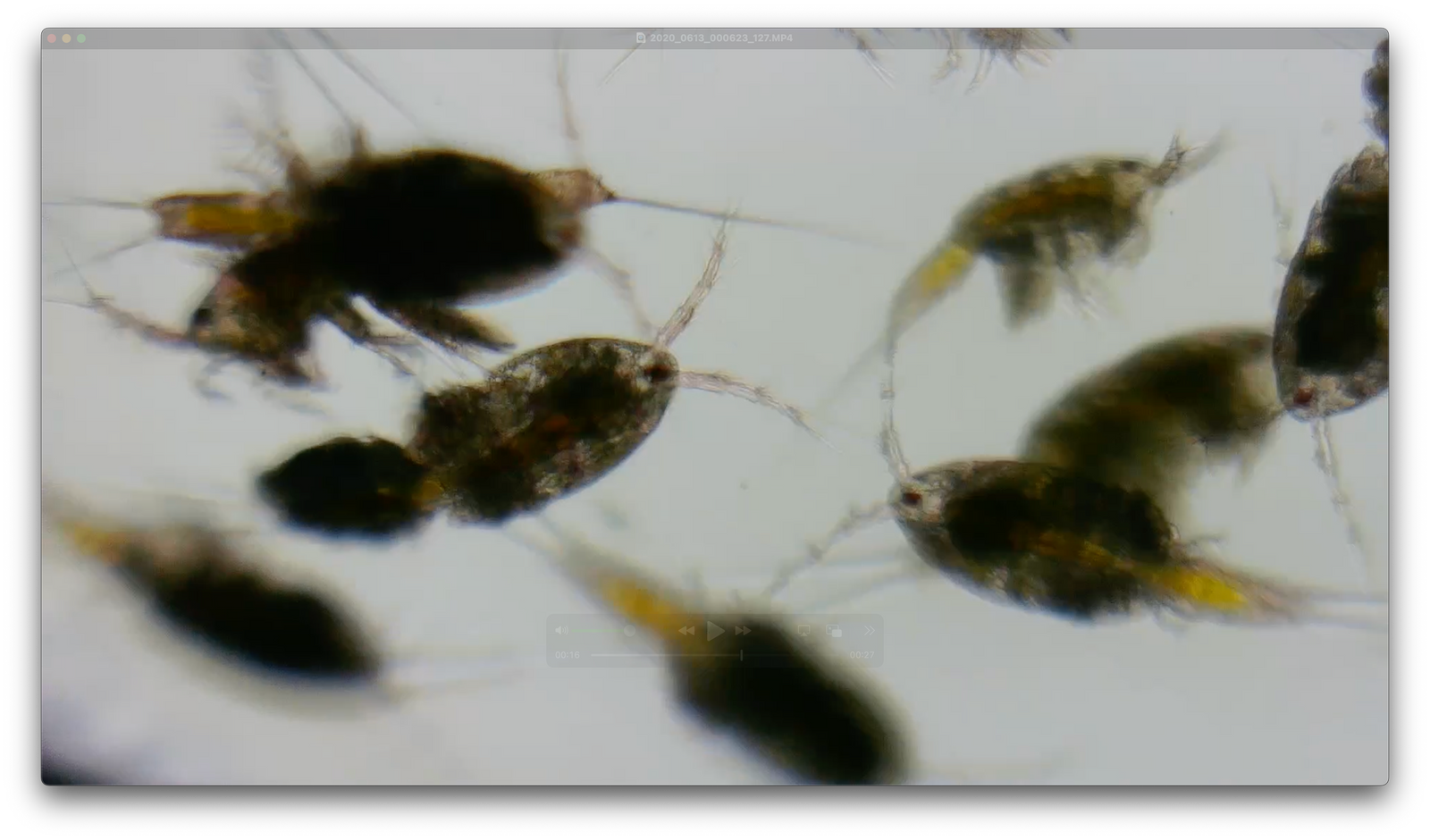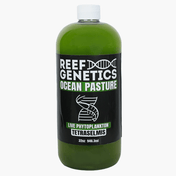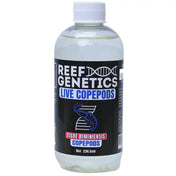Why Copepod Selection Matters
Each Species Plays a Different Role
Copepods are more than just live food—they’re functional parts of your reef system’s ecosystem. Each species behaves differently, fills a unique ecological niche, and supports different types of livestock. Some copepods crawl through substrate and clean up detritus, while others dart through open water to trigger a feeding response in picky fish. Understanding these differences helps you choose the right species—or combination—for your tank’s specific needs.
A common mistake among hobbyists is assuming that any copepod will do the job. In reality, the wrong type may go uneaten, get wiped out quickly, or fail to thrive in your environment. That’s why selection matters: when paired correctly with your livestock and tank setup, the right copepod species becomes a long-term asset—not just a temporary supplement.
Key Factors That Vary Between Species
To make the most informed decision, here are the main attributes to consider when comparing copepods:
- Size: Some species are microscopic, ideal for corals and fry, while others are larger and more visible to fish.
- Swim Behavior: Copepods may crawl (benthic), swim midwater, or hover near the surface—each behavior influences which animals will eat them.
- Reproductive Speed: Some reproduce faster than others, making them better for seeding and maintaining populations.
- Feeding Targets: Different species cater to different livestock, from picky fish to filter-feeding corals.
-
Habitat Preference: Some copepods thrive in refugiums; others do better in open water or live rock areas.
Choosing your copepods based on these factors can lead to a healthier, more self-sustaining tank—and much better results when feeding delicate or specialized livestock.
Tisbe biminiensis – The Stealthy Substrate Crawler
Overview & Behavior
Tisbe biminiensis is a small, benthic copepod species known for its ability to hide and thrive within the rockwork, sandbed, and macroalgae of reef tanks. Unlike swimming species that are more exposed to predation, Tisbe prefers to crawl through crevices and substrate, where it’s protected and able to reproduce without immediate pressure from fish.
This behavior makes it a long-term resident in well-established systems—especially those with refugiums, rubble zones, or thick macroalgae beds like Chaetomorpha. Even in display tanks, if conditions are favorable, Tisbe can quietly establish a stable population in low-flow areas.
Strengths
- Tiny Size for Maximum Accessibility: At ~50–100μm, Tisbe adults are small enough to be consumed by coral polyps, filter feeders, fish fry, and nano species. Their larvae (nauplii) are even smaller and ideal for broadcast feeding.
- Excellent Survivability: Because they remain hidden in hard-to-reach areas, they’re less likely to be decimated by fish or overfiltration. This makes them one of the best options for maintaining a steady pod population over time.
- Natural Detritus Cleanup: Tisbe plays a secondary role as a cleanup crew—grazing on biofilms, detritus, film algae, and uneaten food particles in both refugiums and display tanks.
-
Great for Coral-Heavy Tanks: Their size and availability make them a fantastic live food source for LPS, non-photosynthetic corals, and filter-feeding inverts.
Best For:
- Refugiums & Substrate Zones: Tisbe thrives in refugiums, especially when paired with macroalgae and live rock.
- Long-Term Pod Populations: Great for hobbyists who want stable, self-sustaining microfauna without needing to re-dose often.
-
Coral Nutrition: Especially valuable for tanks with corals that benefit from small particulate feeding.
Apocyclops panamensis – The Midwater Feeder Favorite
Overview & Behavior
Apocyclops panamensis is a small, fast-swimming copepod species that actively moves throughout the water column. Unlike benthic species that stay hidden, Apocyclops is almost always in motion—making it highly visible and accessible to fish and filter feeders.
One unique trait of this species is its egg-carrying reproduction strategy. Females carry visible egg sacs, which hatch quickly into nauplii that begin cycling through life stages in a matter of days. This rapid reproduction makes Apocyclops an ideal candidate for establishing pod populations in both display tanks and refugiums.
Strengths
- Constant Movement Stimulates Feeding: The swimming behavior of Apocyclops closely mimics zooplankton movement in the ocean. Fish like mandarins, wrasses, gobies, and anthias naturally hone in on this motion, leading to a strong feeding response—even in fish that typically ignore frozen or pellet foods.
- Fast Reproduction Cycle: Their ability to quickly populate a tank makes them one of the best choices for seeding new systems or rebuilding pod populations after medications or nutrient spikes.
- Flexible Habitat Compatibility: They do well in both display tanks and refugiums, and they can tolerate a wide range of salinities, including full-strength seawater (1.026), brackish, and even near-fresh conditions during culture.
- Coral and Invert Nutrition: The smaller nauplii stages are ideal for filter-feeding corals, sponges, and even bivalves, while adults are more suitable for fish.
Best For:
- Display Tanks: Perfect for open systems where you want pods visible and actively hunted.
- Seeding New Systems: Ideal for new tanks where establishing a quick pod base is a priority.
- Picky Fish Feeding: A must-have for mandarins, scooter blennies, and small wrasses.
Balanced Feeding Strategy: Complements benthic species like Tisbe to provide full coverage of the tank’s feeding zones.
Tigriopus californicus – The Bold Surface Swimmer
Overview & Behavior
Apocyclops panamensis is a small, fast-swimming copepod species that actively moves throughout the water column. Unlike benthic species that stay hidden, Apocyclops is almost always in motion—making it highly visible and accessible to fish and filter feeders.
One unique trait of this species is its egg-carrying reproduction strategy. Females carry visible egg sacs, which hatch quickly into nauplii that begin cycling through life stages in a matter of days. This rapid reproduction makes Apocyclops an ideal candidate for establishing pod populations in both display tanks and refugiums.
Strengths
- Constant Movement Stimulates Feeding: The swimming behavior of Apocyclops closely mimics zooplankton movement in the ocean. Fish like mandarins, wrasses, gobies, and anthias naturally hone in on this motion, leading to a strong feeding response—even in fish that typically ignore frozen or pellet foods.
- Fast Reproduction Cycle: Their ability to quickly populate a tank makes them one of the best choices for seeding new systems or rebuilding pod populations after medications or nutrient spikes.
- Flexible Habitat Compatibility: They do well in both display tanks and refugiums, and they can tolerate a wide range of salinities, including full-strength seawater (1.026), brackish, and even near-fresh conditions during culture.
-
Coral and Invert Nutrition: The smaller nauplii stages are ideal for filter-feeding corals, sponges, and even bivalves, while adults are more suitable for fish.
Best For:
- Display Tanks: Perfect for open systems where you want pods visible and actively hunted.
- Seeding New Systems: Ideal for new tanks where establishing a quick pod base is a priority.
- Picky Fish Feeding: A must-have for mandarins, scooter blennies, and small wrasses.
- Balanced Feeding Strategy: Complements benthic species like Tisbe to provide full coverage of the tank’s feeding zones.
Blends vs. Single Species – What’s Right for You?
When to Use a Blend
If you're looking for an all-around solution that supports a diverse reef environment, a blended copepod culture is often the best choice. Blends like TSA’s Tisbe + Apocyclops cover multiple feeding behaviors and swim zones—providing both benthic and midwater presence.
The key advantages of blends include:
- Full Water Column Coverage: Tisbe handles the rockwork and substrate, while Apocyclops actively swims through the water column.
- Support for Multiple Livestock Types: A mix supports picky fish, corals, filter feeders, and inverts simultaneously.
- Increased Resilience: Species with different life cycles and behavior patterns improve long-term stability and help prevent boom-and-bust population swings.
-
Convenient Dosing: With a blend, you don’t have to worry about rotating species or balancing populations on your own.
Blends are especially useful in:
- Mixed reef tanks with both corals and fish
- Systems with a refugium and active display tank
-
Tanks housing a wide range of microfauna consumers
When to Use a Single Species
There are cases where targeting a specific copepod species is more appropriate—especially if you’re managing a unique tank setup or working toward a specific goal.
Go with a single species if:
- You’re culturing copepods at home and want more control over conditions
- You’re feeding a particular fish that prefers one species over another (e.g., Tigriopus for surface-feeders, Tisbe for coral-heavy systems)
- You want to experiment with pod density or reproduction rates on your own terms
-
You’re reseeding after treatments and only need one behavior type (e.g., benthic-only after wrasse predation)
Ultimately, both approaches work—blends provide convenience and coverage, while single-species dosing offers precision and flexibility for experienced reefers.
Conclusion: Choosing the Right Copepods for Your Reef
There’s no one-size-fits-all answer when it comes to copepods—but understanding the behavior and strengths of each species helps you build a more balanced, functional reef tank. Whether you're feeding a mandarin that refuses pellets, maintaining a nutrient-exporting refugium, or just trying to boost overall biodiversity, choosing the right copepod (or blend) can make a noticeable difference.
Here’s a quick recap:
- Tisbe biminiensis is best for long-term benthic populations and coral-heavy systems.
- Apocyclops panamensis offers midwater movement and rapid reproduction, ideal for display tanks and picky fish.
- Tigriopus californicus is a highly visible, fatty acid-rich pod that excels at triggering feeding in surface-hunting fish.
- Blends offer broad coverage, making them perfect for most mixed reef setups.
-
Single species allow for specialized feeding or pod culture projects where precise control is preferred.
To get the best results, always start with aquacultured pods that are harvested fresh and gut-loaded—like those from TSA. When supported with phytoplankton and habitat like macroalgae, copepods can become a foundational part of your tank’s long-term success.



















